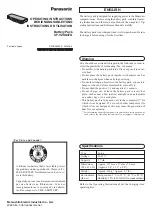
www.lesterelectrical.com 2
01679N
nominal. The charger utilizes convection cooling
which maximizes the reliability and minimizes any
maintenance costs. Only liquid electrolyte (wet) lead
acid batteries should be recharged with this charger
to ensure superior battery performance and life. A
patented electronic circuit turns the charger on and
off automatically. When the battery has reached its
maximum state of charge, the circuitry will turn the
charger off.
RECEIVING AND INSTALLING THE CHARGER
When the charger is received, portable chargers
should be checked for possible in-transit damage. If
any damage is found, it should be reported as a
claim to the carrier.
Proper installation of the charger is important in
order to achieve good charger performance and to
prevent damage to the charger and batteries. The
charger should be located in a clean, cool, dry and
well-ventilated area. To permit free airflow for
convection cooling, allow three inches (3") minimum
between the charger and any wall and six inches
(6") between the charger and other equipment.
Position the charger on a foundation of stone, brick,
concrete or grounded metal.
DANGER: TO REDUCE THE RISK OF FIRE,
DO NOT USE THE CHARGER NEAR
FLAMMABLE MATERIALS OR VAPORS.
AC INPUT AND GROUNDING INSTRUCTIONS
CAUTION: TO REDUCE THE RISK OF
ELECTRIC SHOCK OR FIRE, DISCONNECT
POWER TO RECEPTACLE BEFORE INSTALLING
OR REMOVING UNIT.
For 120 VAC Nominal, 60 Hz Chargers:
Chargers should be grounded to reduce the risk of
electric shock. Charger is equipped with an electric
cord having an equipment-grounding conductor and
a grounding plug. The installed plug must be
plugged into an outlet that is properly installed and
grounded in accordance with all electrical codes and
ordinances.
DANGER: NEVER ALTER AC CORD OR
PLUG PROVIDED IF IT WILL NOT FIT OUTLET.
HAVE A PROPER OUTLET INSTALLED BY A
QUALIFIED ELECTRICIAN. IMPROPER
CONNECTION CAN RESULT IN A RISK OF
ELECTRIC SHOCK.
This battery charger is for use on a nominal 120 volt
circuit and has a grounding plug, which looks like the
adapter illustrated in Figure A. A temporary adapter,
which looks like the adapter illustrated in Figures B
and C, may be used to connect this plug to a two-
pole receptacle as shown in Figure B if a properly
grounded outlet is not available. The temporary
adapter should be used only until a grounded outlet
can be installed by a qualified electrician.
GROUNDING METHODS
NOTE: The use of the adapter shown in figures B
and C is not permitted in Canada.
DANGER: BEFORE USING ADAPTER AS
ILLUSTRATED, BE CERTAIN THE CENTER
SCREW OF OUTLET PANEL IS GROUNDED.
The green-colored rigid ear or lug extending from
adapter must be connected to a properly grounded
outlet. If necessary, replace original outlet cover
plate screw with a longer screw that will secure
adapter ear or lug to outlet plate and make ground
connection to grounded outlet.
For 230 VAC Nominal, 50 Hz Chargers:
This battery charger must be grounded to reduce the
risk of electric shock. This charger is equipped with
an electrical cord having an equipment-grounding
conductor, which must be connected to the ground
prong of an appropriate plug for a nominal 230 Volt,
50 Hertz circuit. This plug must be connected to an
appropriate AC outlet, which is properly installed and
grounded in accordance with the National Electrical
Code and all local codes and ordinances.
EXTENSION CORD REQUIREMENTS
Always use a three conductor No. 12 AWG heavy
duty cord with ground, properly wired, in good
electrical condition and keep it as short as possible.
Make sure the pins on the plug of the extension cord
are the same number, size and shape as the AC
plug of the battery charger. The use of an improper
extension cord could result in a risk of fire or
electrical shock. Locate all cords so they will not be
stepped on, tripped over or otherwise subjected to
damage or stress.
OPERATING INSTRUCTIONS
1. Connect AC supply cord to a properly grounded
single phase outlet of the proper voltage and
frequency as specified on the charger front.























